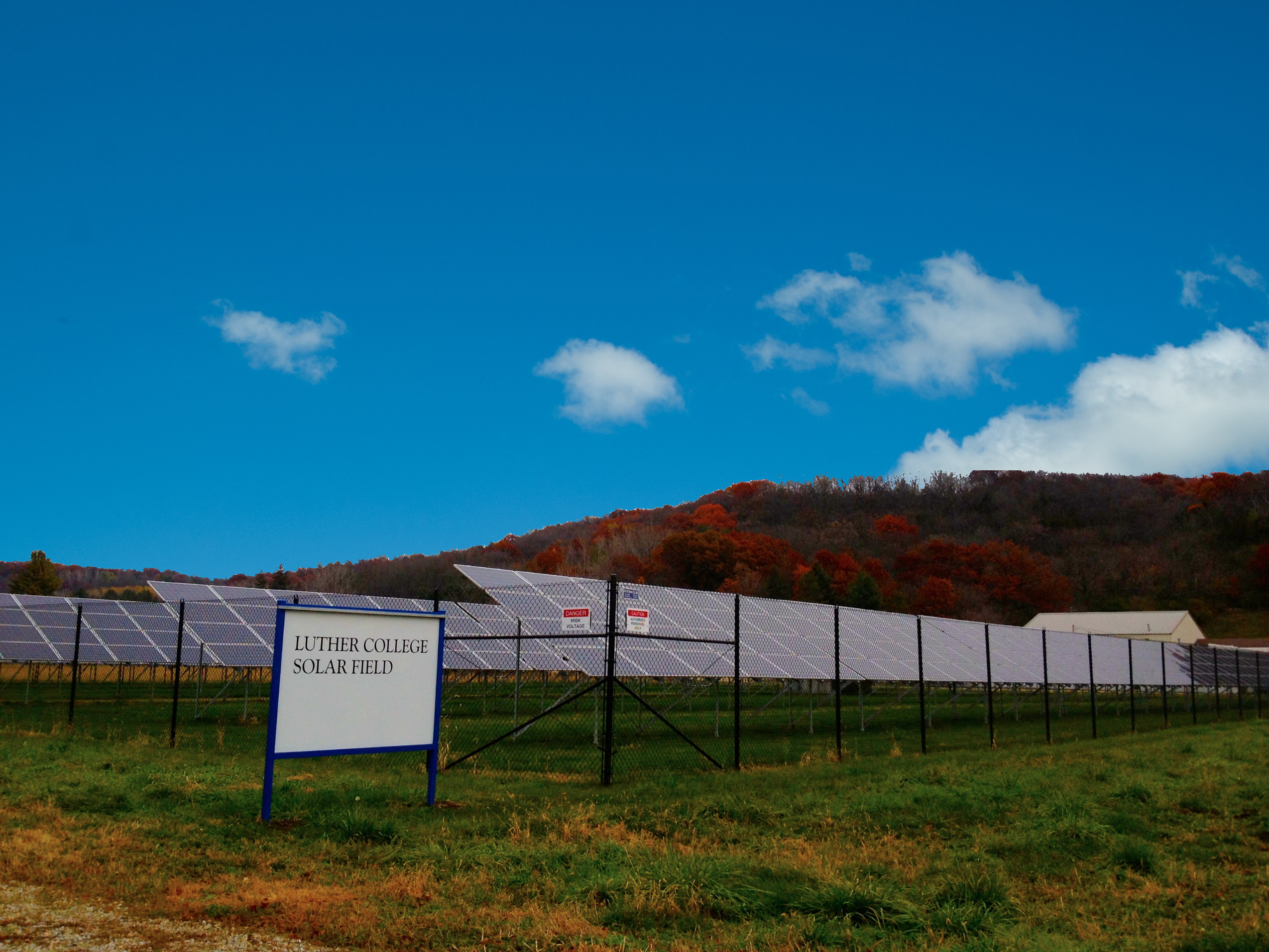Earlier this year I worked as an election judge for the city of Minneapolis. It was the city’s second experience with ranked choice voting, a system where instead of voting for a single candidate, you get to pick your top three choices. If your first choice candidate is mathematically eliminated from winning, your vote is reallocated to your second (or even third) choice.
I tell this story because I feel a bit like a second choice when I’m here to talk to you about campus sustainability when my father literally wrote a book (if not the book) on the culture of campus sustainability, called the Nature of College.
ILSR’s Director of Democratic Energy, John Farrell, gave this presentation at the 5th Annual Conference of the Upper Midwest Association for Campus Sustainability on Nov. 8, 2013. Scroll to the bottom to flip through the accompanying slide presentation.
So I may be a second choice (frankly, I’m my own second choice) but I won’t spend any time second guessing the choice to be here.
I start this conversation about campus sustainability with some of my dad’s thoughts about the struggle between American culture and environmental sustainability. There are several parallels between the broader cultural tension and the tensions between energy utilities and energy consumers. In particular, there are three American Values he highlighted as impediments to sustainability that put an unfortunately small value on the environment: Cheapness, Resourcism, and Silence.
Value 1: Cheapness
Cheapness is the notion that things should be inexpensive. Cheap products tend to fill landfills. In the utility world, cheapness is not just a value, it’s a business model. Utility regulations require the use of “least cost” planning and it therefore becomes the justification for almost every utility action, even when it’s for things that are remarkably expensive. For example, Xcel Energy in Minnesota just spent over $600 million – twice as much as forecast – retrofitting one of their nuclear power plants. This “least cost” retrofit will be quite costly to the utility’s ratepayers.

RevolTee – http://bit.ly/RFDRrk
Least cost is also typically a utility’s the first defense against renewable energy, because utilities operate in a bizarre world where we do not account for the enormous health or environmental cost of acquiring and delivering energy.
The real problem with cheapness in our energy system is that utilities use it to cheapen the consideration of alternatives to their way of doing things.
Value 2: Resourcism
Resourcism is another concept that plays a big role in the utility world. Utilities regularly file “Integrated Resource Plans,” that catalog how we will consume the finite elements of our natural world to generate energy (for the next 10-15 years or more). These integrated plans dis-integrate environmental values from energy generation and can pretend to be least cost by conveniently ignoring the non-monetary value of our natural resources.
Like cheapness, resourcism is a value that reinforces a utility-dominated model of producing energy from dirty, finite sources.
Value 3: Silence
Silence is abundant in our utility system, which is structured to minimize the “noisy” influence of non-utility actors. When we worked to enact a solar energy standard this past year in Minnesota, for example, our hardy band of activists was up against an army of paid lobbyists. When we intervene in proceedings at the public utilities commission, it is a case of non-profit amateurs (like myself) against legions of utility lawyers trying to silence our voice. And all of us as energy customers are only allowed to order our energy choices from the very limited buffet set by our utility.
In these three values, we reinforce an energy system that talks freely about cost and resources, and yet is eerily silent about the billowing pollution from rampant consumption of finite resources.
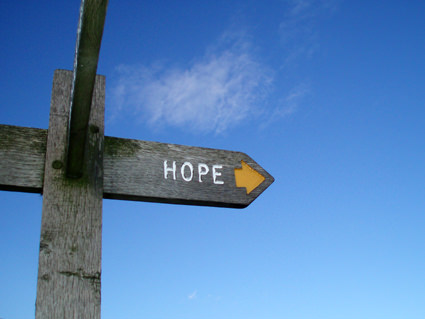
pol sifter, Flickr
This is getting rather depressing.
So I will invoke what my dad called a “hoping mechanism” to deal with this despair.
Hope in a Changing System
The hope arises from the fact that our energy system is changing. It’s a transformation that’s possible because wind and solar and biomass and other renewable energy doesn’t have to be built on a massive scale or owned by a utility. Instead, these energy sources can power and be owned by a neighborhood hardware store. They can generate energy for dozens of farmers in a cooperative. Or they can power a campus from the roof of a dormitory.
And when dozens or hundreds or thousands of us become producers of energy instead of just consumers, we starting thinking less about how much we pay for energy in kilowatt-hours or therms or btus.
We start thinking more about how our energy use aligns with our fundamental values around sustainability; about how the resources we use can be renewable instead of finite, clean instead of dirty, local instead of remote; and we think about how, as energy producers, we are entitled to a voice in the energy system.
Here’s a question that’s at the heart of this change in the energy system: how much do Minnesotans pay each year to import fossil fuels to power their energy system?
The answer is $20 billion
That’s almost 10 percent of the entire state economy.
In a utility-dominated world, that’s simply the cost of doing business. They would even assert that it’s the “least cost.” But Minnesota has enough wind, sun, and other renewable resources to supply the vast majority of its energy needs from within the state. And if the money for that energy stays in the state, it circulates and multiplies within the economy several times over.
Keeping energy dollars in our state means a lot of monetary value, but also a chance to put our values back into our energy system. And an increasing number of people in Minnesota (also represented by a number of state policies) – and in many other places – are starting to take advantage of the opportunities we have to harmonize our energy dollars and our energy values.
As you might guess, utilities are not very happy (whoops, wrong slide) when their customers stop quietly thinking about cost and start thinking how to own and generate power from local, renewable sources.
Their business model keeps churning out new large-scale power plants and transmission lines, many of which have been built on a foundation of erroneous assumptions about growing demand and continued silence about the environmental consequences of a centralized power system. And unfortunately, our regulatory system rewards them for this behavior, frequently granting them a generous rate of return on these ill-fated investments. A new power plant or power line, for example, often rewards utility shareholders with a 10-11% return on investment.
Raise your hand if you see that kind of return on your investments. (No utility shareholders in the audience today…)
But the utility’s investment also relies on one other thing: continued growth in revenues to cover the financing and operating costs of these big new power plants and power lines. And right now utilities are facing a devastating one-two punch to this assumption.
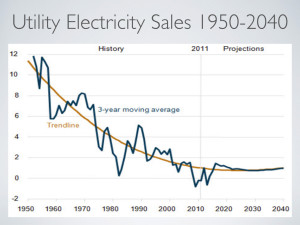 Audience note: we are now getting to the juicy chart section.
Audience note: we are now getting to the juicy chart section.
The first is that the Great Recession largely killed the growth in energy sales. Normally as the economy picks back up, so does energy consumption, but that’s not happening this time, probably because many states have now enacted energy efficiency standards requiring utilities to make use of their lowest cost resource. (Funny how it takes a state law to make sure that utilities ostensibly focused on “least cost” actually invest in their least cost resource.)
The second punch is from the rise of local renewable energy, competing for that remaining pool of energy use. The solar energy I get from my roof, for example, is energy I don’t buy from the utility. If enough customers produce their own power, utilities won’t have enough revenue to cover the costs of operating power plants or power lines built with the assumption of everlasting growth in energy use. The utility’s only recourse is to raise rates, to make more money off their existing energy sales. That, in turn, makes alternatives to utility-delivered power (like my rooftop solar array) that much more attractive. 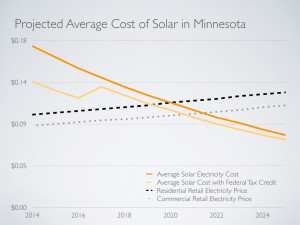 As you can see, by 2020, Minnesota utilities have a major economic problem on their hands as the cost of solar electricity (in yellow and orange) slides below the cost of electricity from the utility (the dotted lines).
As you can see, by 2020, Minnesota utilities have a major economic problem on their hands as the cost of solar electricity (in yellow and orange) slides below the cost of electricity from the utility (the dotted lines).
In other words, the utility business model is under serious threat from communities (e.g. colleges like St. Olaf or Oberlin or U of M Morris or Luther) that are focused on taking control of their energy future. One article from GreenTechMedia this summer bluntly suggested that utilities must “Adapt or Die,” in a world where their former customers are becoming energy producers.
The problem for utilities is only getting worse. The cost of on-site energy like solar is falling so fast that within the next decade, solar could provide lower cost power (without subsidies) to over 38 million people and to consumers in nearly every state. In 16 states, solar could provide more than 10% of the electricity at prices lower than the utility offers.
And therein lies the opportunity. Utilities are increasingly recognizing that they cannot continue to rely on selling energy, which homes, businesses, or colleges can provide for themselves.
Communities That Can Take Advantage
And colleges, as communities, are uniquely suited to take advantage.
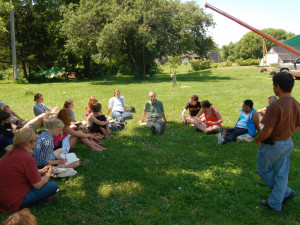 First, they are educational communities. Wendell Berry suggested that, when working most effectively, a “teacher ceases to function merely as a preceptor and becomes an example–an example of something, good or bad, that his [or her] life has proved to be possible.” By their energy choices, colleges will model how sustainable living is or isn’t achieved. Students, staff and faculty will learn something about the opportunity for energy sustainability from their college, whether or not it’s intended.
First, they are educational communities. Wendell Berry suggested that, when working most effectively, a “teacher ceases to function merely as a preceptor and becomes an example–an example of something, good or bad, that his [or her] life has proved to be possible.” By their energy choices, colleges will model how sustainable living is or isn’t achieved. Students, staff and faculty will learn something about the opportunity for energy sustainability from their college, whether or not it’s intended.
Colleges are also mission-driven communities, which means they can challenge the American values of Cheapness, Resourcism, and Silence with values like Renewable, Local, and Democratic. It also means that colleges can be held accountable if the example they provide is not in harmony with their values or their their mission.
But at their best, colleges can also be energy communities. They can fulfill their educational mission by being examples of sustainable living and generating their own power. Colleges can also generate power by helping organize to change the rules and regulations of the energy system to make it easier to transition from dirty energy to clean, and to let more people transition from being energy consumers to producers.
And it starts with those three alternate values I just mentioned.
Alternate Values: Renewable, Local, Democratic
Renewable we all understand, but the other two values are just as important in developing an energy system that resonates with our concept of sustainability.
A local energy system is a value. It is one that does not extract resources from a distant place, but rather taps the resources within our community – natural, human, or financial – and builds them up to allow the community to be more environmentally and economically sustainable. It also does not require the centralization of capital or ownership because the scale of the energy system is commensurate with the scale of the community, and within the economic potential of the community to construct and own.
A democratic energy system is also essential. It means that anyone has the potential to generate their own power, whether individually or collectively. It means that an energy system built on widely dispersed and community-scaled power plants should be governed by widely dispersed and community-scaled institutions like cooperatives or cities, not corporations.
Building an energy system on these values may seem idealistic, but it may be the only way to respond quickly enough to our most pressing sustainability challenge: climate change. That’s because climate change itself has become a hotly contested political issue, causing gridlock when we need the pedal to the floor.
But local and democratic renewable energy can cut across politics.
In Georgia, when the public utilities commission was debating a new solar program by the state’s largest utility, the resulting program exceeded all expectations because of a collaboration called the Green Tea Coalition. It brought together environmentalists with the Tea Party to insist that residents of Georgia had a right to produce their own energy from solar and that the utility needed to allow them that energy freedom.
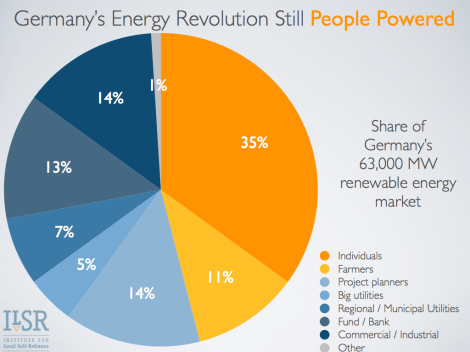
And as these Tea Partiers put solar on their roofs and garages and churches, they will transform from climate deniers to clean energy voters, but only so long as the rules we write give them the chance to be their own energy producers.
So it’s not enough to pass a renewable energy standard that leaves the work (and profits) in the hands of utilities, when we examples of energy programs like Germany (they call it a feed-in tariff) that has put half of the country’s wind and solar energy in the hands of ordinary people. It’s not enough to offer tax incentives for renewable energy that work well for corporations, but leave cooperatives and nonprofits and colleges without the same opportunity to own renewable energy systems.
That means that as we advance the notion of campus sustainability, it’s not just about generating power for a campus (or composting, or other inward-facing initiatives). It must also be about generating power from campuses to create a sustainable energy system. A system that embodies the core values of sustainability, that creates policies that maximize local and democratic energy, and that gives us a fighting chance against climate change.
Are we up to the challenge? I’ll leave you with this thought from Jim Farrell:
If God had wanted us to live sustainably, she’d have given us brains
Thank you
——————————
[protected-iframe id=”cbec39113a34fc07dba9c09b661d2094-5104299-27880469″ info=”http://www.slideshare.net/slideshow/embed_code/28120950″ width=”427″ height=”356″ frameborder=”0″ scrolling=”no” allowfullscreen=””]
Like what you see? Get a weekly email about a democratic energy future! or read more from ILSR’s Democratic Energy program.

